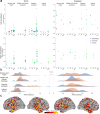Imagined speech can be decoded from low- and cross-frequency intracranial EEG features
- PMID: 35013268
- PMCID: PMC8748882
- DOI: 10.1038/s41467-021-27725-3
Imagined speech can be decoded from low- and cross-frequency intracranial EEG features
Abstract
Reconstructing intended speech from neural activity using brain-computer interfaces holds great promises for people with severe speech production deficits. While decoding overt speech has progressed, decoding imagined speech has met limited success, mainly because the associated neural signals are weak and variable compared to overt speech, hence difficult to decode by learning algorithms. We obtained three electrocorticography datasets from 13 patients, with electrodes implanted for epilepsy evaluation, who performed overt and imagined speech production tasks. Based on recent theories of speech neural processing, we extracted consistent and specific neural features usable for future brain computer interfaces, and assessed their performance to discriminate speech items in articulatory, phonetic, and vocalic representation spaces. While high-frequency activity provided the best signal for overt speech, both low- and higher-frequency power and local cross-frequency contributed to imagined speech decoding, in particular in phonetic and vocalic, i.e. perceptual, spaces. These findings show that low-frequency power and cross-frequency dynamics contain key information for imagined speech decoding.
© 2022. The Author(s).
Conflict of interest statement
The authors declare no competing interests.
Figures







Similar articles
-
The use of intracranial recordings to decode human language: Challenges and opportunities.Brain Lang. 2019 Jun;193:73-83. doi: 10.1016/j.bandl.2016.06.003. Epub 2016 Jul 1. Brain Lang. 2019. PMID: 27377299 Free PMC article. Review.
-
Decoding Neural Correlation of Language-Specific Imagined Speech using EEG Signals.Annu Int Conf IEEE Eng Med Biol Soc. 2022 Jul;2022:1977-1980. doi: 10.1109/EMBC48229.2022.9871721. Annu Int Conf IEEE Eng Med Biol Soc. 2022. PMID: 36086641
-
Resting state EEG assisted imagined vowel phonemes recognition by native and non-native speakers using brain connectivity measures.Phys Eng Sci Med. 2024 Sep;47(3):939-954. doi: 10.1007/s13246-024-01417-w. Epub 2024 Apr 22. Phys Eng Sci Med. 2024. PMID: 38647635
-
Feasibility of decoding covert speech in ECoG with a Transformer trained on overt speech.Sci Rep. 2024 May 20;14(1):11491. doi: 10.1038/s41598-024-62230-9. Sci Rep. 2024. PMID: 38769115 Free PMC article.
-
The Potential for a Speech Brain-Computer Interface Using Chronic Electrocorticography.Neurotherapeutics. 2019 Jan;16(1):144-165. doi: 10.1007/s13311-018-00692-2. Neurotherapeutics. 2019. PMID: 30617653 Free PMC article. Review.
Cited by
-
Theta-gamma phase-amplitude coupling in auditory cortex is modulated by language proficiency.Hum Brain Mapp. 2023 May;44(7):2862-2872. doi: 10.1002/hbm.26250. Epub 2023 Feb 27. Hum Brain Mapp. 2023. PMID: 36852454 Free PMC article.
-
Dataset of Speech Production in intracranial.Electroencephalography.Sci Data. 2022 Jul 22;9(1):434. doi: 10.1038/s41597-022-01542-9. Sci Data. 2022. PMID: 35869138 Free PMC article.
-
Stable Decoding from a Speech BCI Enables Control for an Individual with ALS without Recalibration for 3 Months.Adv Sci (Weinh). 2023 Dec;10(35):e2304853. doi: 10.1002/advs.202304853. Epub 2023 Oct 24. Adv Sci (Weinh). 2023. PMID: 37875404 Free PMC article.
-
Measuring the menu, not the food: "psychometric" data may instead measure "lingometrics" (and miss its greatest potential).Front Psychol. 2024 Mar 21;15:1308098. doi: 10.3389/fpsyg.2024.1308098. eCollection 2024. Front Psychol. 2024. PMID: 38577112 Free PMC article. Review.
-
Chisco: An EEG-based BCI dataset for decoding of imagined speech.Sci Data. 2024 Nov 21;11(1):1265. doi: 10.1038/s41597-024-04114-1. Sci Data. 2024. PMID: 39572577 Free PMC article.
References
Publication types
MeSH terms
Grants and funding
LinkOut - more resources
Full Text Sources
Miscellaneous

